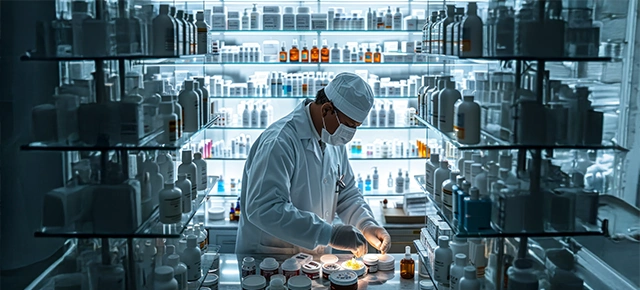Shedding Light on Monochromatic and Amber Lighting in Pharmaceutical Industry Environments
In the pharmaceutical industry, lighting plays a crucial role beyond mere illumination. It affects various aspects of operations, including productivity, safety, and product quality. Among the different lighting options available, monochromatic and amber lighting have gained attention for their specific benefits in pharmaceutical environments. This blog explores the impact of monochromatic and amber lighting in pharmaceutical industry settings and how they contribute to improved outcomes.
Monochromatic Lighting:
Monochromatic lighting emits a single wavelength or color of light, providing consistent and uniform illumination without spectral variations. In pharmaceutical facilities, monochromatic lighting is often utilized for its ability to enhance visual clarity and reduce color distortion, which is critical during tasks such as quality control inspections and labeling processes. The uniformity of monochromatic light ensures accurate color representation, allowing personnel to identify discrepancies or impurities in pharmaceutical products with precision.
Benefits of Monochromatic Lighting in Pharmaceutical Environments:
- Enhanced Color Differentiation: Monochromatic lighting eliminates spectral variations, resulting in improved color differentiation and accuracy during quality control inspections and product labeling processes. Personnel can identify subtle color variations and irregularities more effectively, ensuring compliance with quality standards and regulatory requirements.
- Reduced Eye Strain: The uniformity of monochromatic light reduces eye strain and fatigue among personnel engaged in visually demanding tasks, such as reading labels, analyzing samples, or conducting inspections. By providing consistent and comfortable illumination, monochromatic lighting enhances productivity and focus while minimizing the risk of visual errors and fatigue-related mistakes.
- Improved Product Quality: Accurate color differentiation facilitated by monochromatic lighting contributes to improved product quality and consistency in pharmaceutical manufacturing processes. Personnel can detect impurities, discolorations, or inconsistencies more easily, allowing for timely intervention and corrective measures to maintain product integrity and meet quality standards.
Applications of Monochromatic Lighting in Pharmaceutical Environments:
- Quality Control Inspections: Monochromatic lighting is widely used during quality control inspections to assess the color consistency and integrity of pharmaceutical products. By providing uniform illumination without spectral variations, monochromatic lighting ensures accurate color representation, enabling personnel to identify impurities or deviations from quality standards.
- Labeling and Packaging: Monochromatic lighting plays a crucial role in labeling and packaging processes, where precise color matching is essential for compliance and brand consistency. Personnel can rely on monochromatic lighting to ensure that labels, packaging materials, and product inserts maintain consistent color accuracy, enhancing product presentation and consumer perception.
- Laboratory Analysis: In pharmaceutical laboratories, monochromatic lighting is employed during sample analysis and experimentation to minimize color distortion and ensure reliable results. By eliminating spectral variations, monochromatic lighting enhances the visibility of sample characteristics and allows researchers to observe subtle color changes or reactions with greater accuracy.
Amber Lighting:
Amber lighting emits a warm, golden hue that is soothing to the eyes and creates a calming ambiance. In pharmaceutical environments, where precision, focus, and attention to detail are paramount, amber lighting offers unique benefits that complement monochromatic lighting. It helps create a conducive work environment conducive to concentration and productivity while reducing glare and visual distractions.
Benefits of Amber Lighting in Pharmaceutical Environments:
- Reduced Glare and Reflections: Amber lighting minimizes glare and reflections, creating a softer and more diffused illumination that is gentle on the eyes. This reduces visual discomfort and fatigue among personnel, allowing them to work for extended periods without experiencing eye strain or discomfort.
- Enhanced Visual Comfort: The warm, golden hue of amber lighting creates a cozy and inviting atmosphere in pharmaceutical facilities, promoting a sense of calm and well-being among personnel. This enhances morale and productivity while reducing stress levels, contributing to a positive work environment conducive to focus and concentration.
- Optimal Circadian Rhythm Alignment: Amber lighting helps regulate circadian rhythms by minimizing exposure to blue light, which can disrupt sleep patterns and cause fatigue. In pharmaceutical settings where shift work is common, amber lighting supports employee well-being by promoting restful sleep and maintaining healthy sleep-wake cycles, ultimately improving alertness and performance on the job.
Applications of Amber Lighting in Pharmaceutical Environments:
- Cleanroom Environments: Amber lighting is often used in cleanroom environments within pharmaceutical facilities to create a calming and visually comfortable atmosphere for personnel. The warm, golden hue of amber lighting reduces glare and harsh contrasts, promoting a sense of relaxation and focus among cleanroom workers engaged in precision tasks.
- Employee Break Areas: In pharmaceutical manufacturing facilities, employee break areas are equipped with amber lighting to provide a respite from the intense lighting conditions of production areas. The soft, ambient glow of amber lighting creates a welcoming and rejuvenating space where personnel can unwind and recharge during breaks, enhancing morale and well-being.
- Office Spaces and Meeting Rooms: Amber lighting is utilized in office spaces and meeting rooms within pharmaceutical facilities to foster a conducive work environment for administrative staff and management. The warm, inviting ambiance of amber lighting promotes concentration and productivity during meetings and collaborative work sessions while reducing eye strain and fatigue associated with prolonged screen time.
Enhancing & Illuminating Pharmaceutical Environments
Monochromatic and amber lighting play distinct yet complementary roles in pharmaceutical industry environments, offering unique benefits that contribute to improved productivity, safety, and product quality. While monochromatic lighting enhances color differentiation and visual clarity during critical tasks, amber lighting creates a calming and comfortable ambiance that promotes focus and well-being. By understanding the impact of these lighting options and leveraging their benefits effectively, pharmaceutical facilities can create optimal working environments that support employee performance and organizational success. Get in touch with us to know more about our lighting solutions for pharmaceutical industries.






